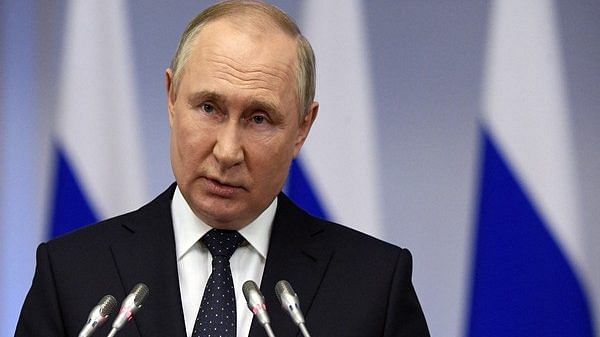On 24 February this year, Russia crossed the Rubicon in the Ukraine crisis and intervened directly in what had until then been a festering but limited conflict since 2014. The Ukraine war is now poised to enter a third phase.
The opening phase of the Russian intervention was aimed at coercive diplomacy with the introduction of a credible force presence inside Ukraine. As we now know from Western sources, the Ukrainian regime had initially been receptive to a negotiated settlement in March, broadly on the terms of Ukraine committing itself to permanent geopolitical neutrality and constitutional safeguards for the millions of ethnic Russians in eastern Ukraine (in accordance with the previous Minsk Agreements), in exchange for a Russian withdrawal. But the US vetoed an early peaceful resolution to the conflict, as it saw an opportunity to bleed Russia in a prolonged proxy war.
The Russians followed their initial restraint and siege of Kiev by shifting to a concentrated use of force as part of a more focused military strategy to secure the Russian-populated regions of eastern and southern Ukraine. Nearly 200,000 Russian troops, supported in combined arms operations backed by massive use of artillery, long range missiles, and air power, managed to carve out a sphere of influence in a large portion of the Donbass region. Russia also succeeded in effectively blockading Ukraine from access to the Black Sea.
The main reason for this incremental approach was that since 2014, Ukraine had developed an elaborate system of defence lines surrounding the Donbass that made a head-on attack extremely costly for Russian troops. At any rate, Russia has managed to create a new 1,000 km long frontline in Ukraine and placed under its control a major part of the historical lands of Novorossiya where 7.5 million people live, the majority being ethnic Russians.
However, Russia’s goal of toppling the regime or atleast bringing it to the negotiating table has been stymied by stubborn Western support and extraordinary sway over Ukrainian decision makers, who seem unmoved by the unprecedented number of casualties. The Russian Ministry of Defense estimates upto 100,000 Ukrainians dead or wounded and nearly 6,000 Russians killed in action. Ukrainian sources paint a grave picture too.
Dealing with such a set of circumstances – where a proxy regime and its people have become cannon fodder for the US and NATO at the expense of Ukrainian long-term interests – has come as a bitter pill for the Kremlin. Eight long years preceding the outbreak of hostilities in February 2022 had obviously entrenched US and NATO influence over Ukraine to the point where it had become a member of the alliance in all but name. Indeed, the sacrifices being made in European households starved of affordable gas or fuel, the impending collapse of German industry and European manufacturing more broadly, and US inflation (or stagflation) are far greater than any cost that the NATO alliance has ever borne to safeguard a potential member State.
Also read: Modi’s vishwa guru quest continues. Australia visit will help India wean Canberra away from China
The strategic rethink
At the same time, the US and NATO have managed to avoid a direct collision with Russia, by advertising the fiction of their ‘limited’ support to Ukraine. This dilemma of deterring a growing Western involvement and the reality of Russia fighting a war with one-hand tied behind its back, has led to a major strategic rethink in the Kremlin’s strategy.
On 21 September, Putin announced a “partial mobilisation” of about 300,000 troops from Russian reserves who will undergo training in the subsequent weeks and months for possible deployment in the winter season. This would effectively more than double the Russian military strength in Ukraine. “Washington, London and Brussels are openly encouraging Kiev to move the hostilities to our territory. They openly say that Russia must be defeated on the battlefield by any means”. Putin then raised the stakes dramatically: “In the event of a threat to the territorial integrity of our country and to defend Russia and our people, we will certainly make use of all weapon systems available to us. This is not a bluff.” Putin also declared that the Donbass people’s republics and the Kherson and Zaporozhye regions would hold referendums on the future of their territories, hinting at their impending integration with Russia since the majority of the inhabitants are ethnic Russians.
The ball is soon going to be back in the US court. What is no longer in doubt is that the US is now a de facto participant in this war, given NATO’s comprehensive involvement in Ukrainian military operations – from providing command and control support, to deploying special forces mercenaries, to satellite-based and strategic drone-based reconnaissance on Russian positions, to training Ukrainian units and pumping in weapons and hardware. Or as Putin remarked, the Russian armed forces face “the entire military machine of the collective West.”
By signaling an escalation, Putin has altered that calculus. The prospect of Russia’s nuclear umbrella being extended over the Donbass – or what will soon constitute the new Russian frontiers – after the September-end referendums means that any future NATO-supported Ukrainian offensive might involve serious reprisals for the West.
So far, the US has denied Russia a quick or easy victory, albeit at the cost of massive Ukrainian casualties as well as the loss of its major industrial, energy-infrastructure and resource-rich areas. Moscow is betting on a harsh energy-starved cold spell for Europe along with a more favourable balance of forces on the battlefield once the Ukrainian winter sets in.
Phase three of the Ukrainian conflict is likely to be the most decisive and dangerous chapter in the struggle between the US and Russia.
Daulet Singh is a historian based in New Delhi and author, most recently, of Powershift: India-China Relations in a Multipolar World. Views are personal.
(Edited by Anurag Chaubey)



